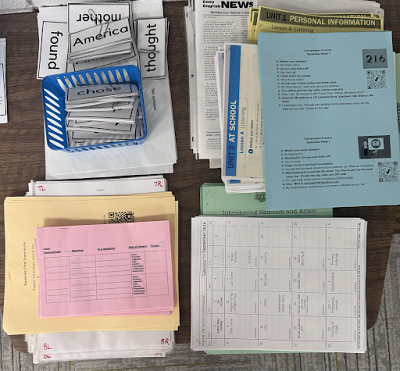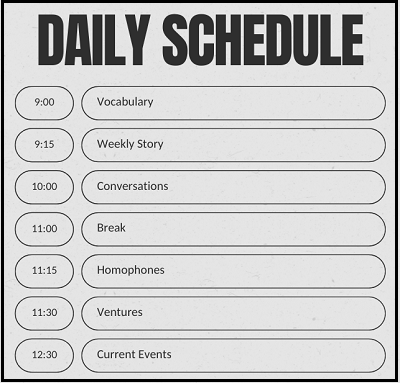- MN ABE Connect
- Archive
- Creating Systems, Establishing Routines, and Collaborating to Boost Student Achievement
 September 16, 2024
September 16, 2024
Creating Systems, Establishing Routines, and Collaborating to Boost Student Achievement
Kimberly Sombke, EL TeacherWe all want our students to feel comfortable from the moment they step foot into our classrooms. However, if you’ve ever taken the PD session, “From the Other Side of the Desk” from Andrea Echelberger, you know that all of our warmth and welcoming smiles aren’t enough to put EL students at ease. (If you’ve never taken this session, would recommend! 5 out of 5 stars! Dare I say, it’s life-changing!) Side note: this particular session was a result of this article, written by Echelberger in 2016.
So what can we do for our students who are sometimes overwhelmed with anxiety? Haven’t we all been shocked that, after a few weeks in our classes, a student has fantastic English skills that weren’t apparent on day one because of a lack of confidence and general jitters? There are some routines and systems that we can provide for students so that they can maximize their time with us and, hopefully, help our programs retain students at a greater rate.
Color coding
 One system that can benefit students is overall color-coding. For example, for my classes, Ventures lessons are always copied onto yellow paper, weekly stories are always copied onto blue paper, and sight words are always copied onto pink paper. Seems too easy, doesn’t it? But this simple and proactive step can help students acclimate quickly into the classroom when language is the barrier.
One system that can benefit students is overall color-coding. For example, for my classes, Ventures lessons are always copied onto yellow paper, weekly stories are always copied onto blue paper, and sight words are always copied onto pink paper. Seems too easy, doesn’t it? But this simple and proactive step can help students acclimate quickly into the classroom when language is the barrier.
When an instructor asks students to find their pink papers, they can locate them inside of their folders or binders rapidly and with confidence, especially when the teacher displays the paper copy to the class. They don’t need to know the word “pink” if they can see it. (Of course students that are color-blind may struggle with this admittedly–shapes in the corners or adding a page protector could benefit these students.) This system is even better when all levels follow the same general color-coding.
Routines
Establishing routines is another great way to support student acclimation and success. Most of us appreciate (even survive on) a set schedule and knowing what to expect from our day. Our students are definitely no exception! When your days are organized and repeated, you as the instructor can also better manage planning and organization.
 Displaying the schedule, too, is helpful. Students can follow along when they can see something like this Daily Schedule.
Displaying the schedule, too, is helpful. Students can follow along when they can see something like this Daily Schedule.
You may notice that this schedule is structured without any details. This is intentional so as not to overwhelm students with too much English (in general, best practice suggests a less ‘busy’ classroom will help with focus anyway).
Following a routine schedule and establishing classroom norms will help students (and teachers) fall into a much-needed groove in order to find a comfortable foundation that promotes learning and growth.
Collaboration
When implementing systems and routines, be sure to include the teachers down the hall. Perhaps you think that collaborating with co-instructors seems like a far-off notion because, honestly, who has the time? Let’s look at some easy-to-implement ideas that are both low stakes and worthy of any investment in time that is necessary.
First, invite a co-teacher (or two) to collaborate on a file via Teams or Google Drive. Maybe it’s as simple as a classroom poster that illustrates common teacher directions. Maybe it’s monthly vocabulary lessons (based on the theme of the month?), providing scaffolding from level to level as the rigor subsequently increases.
 Does it really matter if you teach the vocabulary differently? Definitely not. In fact, it’s better that way since we all bring a different lens to our classrooms. Does it help students who transition up a level to feel some familiarity and comfort? Definitely yes! Of course this type of monthly activity requires a bit of a time commitment upfront, but after the first year, it’s easy to update the dates, days off, and holidays. You may want to even create an accompanying slideshow to match the vocabulary calendar–and don’t forget to share it with your collaborating team.
Does it really matter if you teach the vocabulary differently? Definitely not. In fact, it’s better that way since we all bring a different lens to our classrooms. Does it help students who transition up a level to feel some familiarity and comfort? Definitely yes! Of course this type of monthly activity requires a bit of a time commitment upfront, but after the first year, it’s easy to update the dates, days off, and holidays. You may want to even create an accompanying slideshow to match the vocabulary calendar–and don’t forget to share it with your collaborating team.
In addition, a simple conversation with our peers could reveal some tricks that we can all use. How many ways can we count out syllables? Bunches. What if we all count out syllables the same way, level one all the way to level six? Can we adopt the same translation app or website at our sites? Consistency and continuity through collaboration: the trifecta of Cs! Of course these are just a few ideas. What is important enough to you to collaborate on with other instructors that will ultimately lead to great student achievement? That’s always the goal.
When we can incorporate routines and establish systems into our instruction and programming, we’ve laid a strong foundation for our students’ successes, in the classroom and in their daily lives outside of it.

Newsletter Signup
Get MN ABE Connect—the official source for ABE events, activities, and resources!
Sign UpArticle Categories
- ABE Foundations/Staff Onboarding
- ACES/Transitions
- Adult Career Pathways
- Assessment
- CCR Standards
- Citizenship
- COVID-19
- Cultural Competency
- Digital Literacy/Northstar
- Disabilities
- Distance Learning/Education
- ELA
- Equity/Inclusion
- ESL
- HSE/Adult Diploma
- Listening
- Math/Numeracy
- Mental Health
- Minnesota ABE
- One-Room Schoolhouse/Multilevel
- Professional Development
- Program Management
- Reading
- Remote Instruction
- Science
- Social Studies
- Speaking/Conversation
- Support Services
- Teaching Strategies
- Technology
- Uncategorized
- Volunteers/Tutors
- Writing